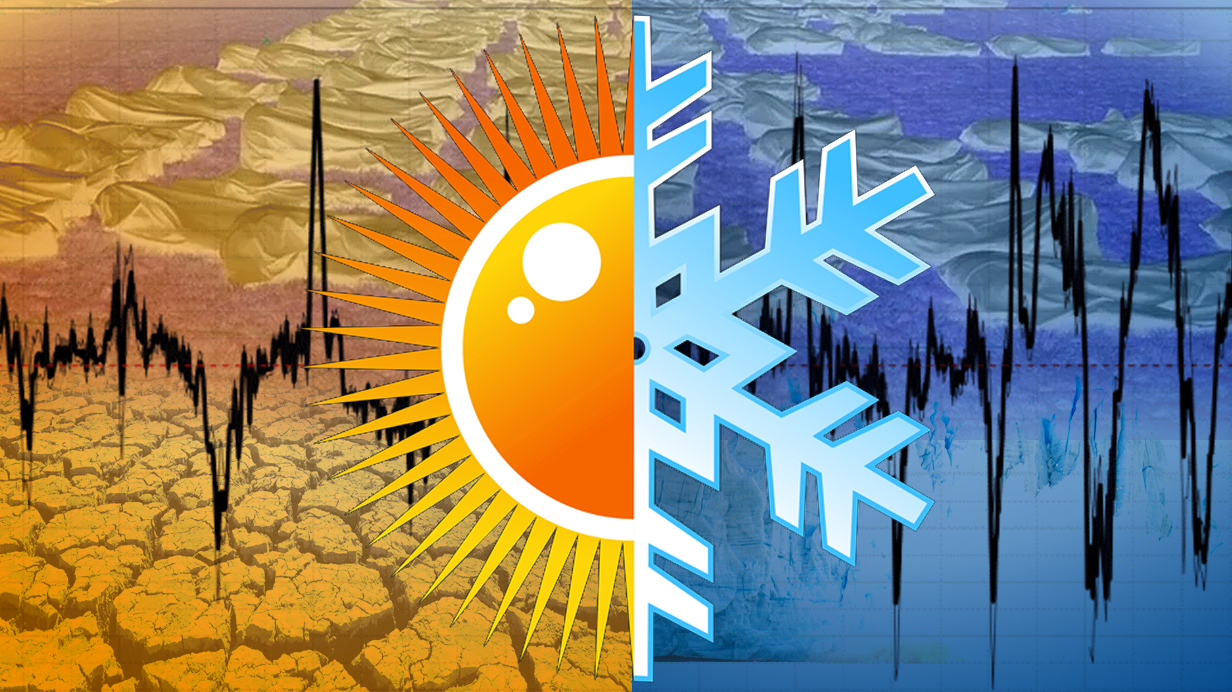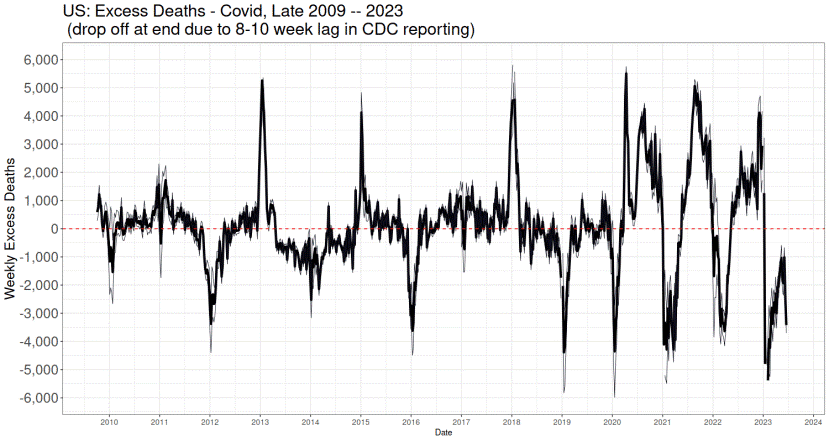
July 26, 2023
Guest Perspective by William Briggs
Recall there is no such thing as unconditional “excess deaths”. Which is to say, there is no such thing as “excess deaths” per se. They can only exist conditional on some model.
For instance, here (as regular readers saw hundreds of times during the needless covid panic) are weekly all cause deaths in the USA, or so claims the CDC. I first subtracted all deaths claimed to be from covid, so this is a picture of all deaths except covid (to avoid nauseatingly boring discussions of covid). The green line is a simple model which assumes a linear trend for each week (there is a separate model for each week of the year), the trend to help account for population growth (however that comes about).

If you subtract the model from the average, the result is “excess deaths”, which can even be negative. Meaning times in which not as many people died as the model said would. Why didn’t those were supposed to die not die? Don’t know. Why did people die when the model said they would? Don’t know. Why did more die than the model said would? Don’t know. There is no notion of cause in the model, so there can be none in the “excess deaths.”

How about if we take this “excess death” series and “correlate” with other measures, like, oh, I don’t know, temperature? In other words, we have modeled “excess deaths” and then we next model those “excess deaths” with temperature. If the correlation was, say, positive, could we claim that warmer temperatures were causing more “excess deaths”?
No, sir. We could not.
For one, it’s just correlation! If temperature were slightly “out of phase” from my original model for deaths, we’d have a spurious correlation, which of course would give the wrong idea about cause.
All right, that’s the throat clearing. Now the peer-reviewed paper “Excess mortality attributed to heat and cold: a health impact assessment study in 854 cities in Europe” by Pierre Masselot and others in The Lancet: Planetary Health. The “Excess mortality” signals we’re dealing with a mortality model, as above, and the “attributed”—which is causal language—signals we’re dealing with a temperature model on top of the mortality model.
Now it’s rare for somebody to be killed by temperature. Freezing to death happens, but not that often, and especially not that often in major European cities. Same thing with, say, stroking out in the sun. Just as we saw that other day with heat and blindness, if heat was so deadly by itself, a good swath of the world, like Florida in summer, would emit a big stink from the rotting corpses. Yet, somehow, people survive.
Here are their Methods, which you can skim:
We included urban areas across Europe between Jan 1, 2000, and Dec 12, 2019, using the Urban Audit dataset of Eurostat and adults aged 20 years and older living in these areas. Data were extracted from Eurostat, the Multi-country Multi-city Collaborative Research Network, Moderate Resolution Imaging Spectroradiometer, and Copernicus. We applied a three-stage method to estimate risks of temperature continuously across the age and space dimensions, identifying patterns of vulnerability on the basis of city-specific characteristics and demographic structures. These risks were used to derive minimum mortality temperatures and related percentiles and raw and standardised excess mortality rates for heat and cold aggregated at various geographical levels.
Three stage method!
Now their findings (I added commas in the numbers):
Across the 854 urban areas in Europe, we estimated an annual excess of 203,620 (empirical 95% CI 180,882–224,613) deaths attributed to cold and 20,173 (17,261–22,934) attributed to heat. These corresponded to age-standardised rates of 129 (empirical 95% CI 114–142) and 13 (11–14) deaths per 100,000 person-years. Results differed across Europe and age groups, with the highest effects in eastern European cities for both cold and heat.
So cold is causing, they intimate, some 200,000 extra deaths, and heat is causing about ten times fewer. Every year. Global cooling is a threat!
Well, there are not 200,000 people who freeze to death in Europe every year. Maybe, and only maybe, there are 2; at an extreme stretch, 20. But 200 is unbelievable. And there aren’t a tenth that many who die of heat frustration. So what could have happened to make them say this?
I’m tempted to cut and paste that three-stage method spoken of above. But I’ll resist the temptation because it requires too much familiarity with statistical terminology. In brief, it’s one overly complex non-causal model taken as causal feeding into a second model of the same nature, the output of which is then fed into a third, the uncertainty of each step being abandoned, forlorn, left by the wayside. Model upon model upon model.
They go on to use thick and furious causal language: “mortality impacts” (that’s a noun phrase, friends), “total burden [of deaths] for both cold and heat”, “impact [deaths] of cold”, “heat-related effects”.
They claim cause outright: “This study provides a comprehensive mortality impact assessment related to non-optimal temperatures in the urban population of Europe…”
This is nuts. They have no warrant to claim cause. They can’t even claim it indirectly, through the academic use of flimsy and watery words like “associated”. They have only correlations from the output of one model in other models downstream.